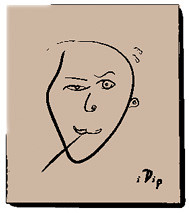Armand Frasco bought his first pocket-size Moleskine notebook at a Restoration Hardware store in a mall in Skokie, Ill. The packaging mentioned that this was ''the legendary notebook of Hemingway, Picasso, Chatwin.'' Frasco's basic reaction to that was, Yeah, right. But he liked the notebook's construction and purchased one. Later he went online and did a search for ''Moleskine'' and ''My Moleskine.'' ''And man,'' he says, ''I saw a lot.'' Modo & Modo, the Italian company that has been producing the notebooks since 1998, sells more than four million a year in about 40 countries. Clearly something not only makes people want to have these notebooks but also makes them want other people to know that they have them. ''We know now that it's sort of a symbol,'' says Samantha Rossini, Modo & Modo's project manager.
The back story (laid out in a multilingual pamphlet that comes with each notebook) goes like this: The original Moleskine notebooks were made by ''small French bookbinders'' and sold in stationery stores in Paris. One devoted buyer was the British writer Bruce Chatwin, who bought them by the score until production stopped in 1986. Rossini says that Chatwin made a point to write his name, address and a reward offer in his Moleskines, should he lose one. Probably he was more interested in saving the words he had written than the object he'd written them on, but never mind. The point is that Modo & Modo decided to revive the notebooks, with a strategy of linking them to the creative people who have used them -- not unlike that old Gap campaign featuring James Dean and Jack Kerouac and other icons who wore khakis. The difference is that the journal signifies not merely style but also creativity. Consumers are encouraged to mail in quotes about writing, for example, for use in a series of postcards and stickers distributed with the notebooks. The core idea, Rossini says, is that these are not just journals; they are ''books without words inside -- your own book.''
This appealing idea brings us back to Armand Frasco. Frasco, who is 42, works in health care and is also a photographer. Early last year, he started a blog called Moleskinerie, which gathers references to Moleskines, observations about creativity, work by contemporary Moleskinners and sightings -- like Sean Penn toting what appeared to be a Moleskine in Tehran. Frasco is by now an informal expert on the relationships between consumers and their notebooks, from the giddy first-time buyers to picky critics to those who treat their Moleskines as fashion accessories. He was ignored by the notebook's U.S. distributor initially, but not long ago he was invited to speak at a trade show. (He says that his site remains independent, and it often includes material about rival products.)
Frasco is onto something when he zeroes in on the physical and aesthetic properties of Moleskines and other journals. He stresses the pleasure of ''analog'' creativity in an increasingly digital world. (He has a separate blog about that.) What may be more important is that the look of Moleskines -- the heavy paper, the elastic band, the pocket on the inside back cover -- does suggest an archetype. That is probably why they were used as props in films like ''Magnolia'' and ''Amélie.'' Modo & Modo pointed me to those films and to an interview in which Dave Eggers talked about designing his book ''How We Are Hungry'' to resemble a Moleskine. ''They're really simple and beautiful,'' he told that interviewer.
Obviously the work of Hemingway and Picasso had about as much do with their Moleskines as it did with their khakis (which both men wore, according to that Gap campaign). Yet the Moleskine just looks like a thing that holds interesting, and possibly important, jottings and sketches. Even if you're carrying it to another boring staff meeting to take notes about sales projections, the notebook makes for a fantastic emblem of creative possibility. Of course, people who actually write for a living sometimes have a different relationship to blank pages. One quotation that probably won't be used to sell Moleskines is John McPhee's 1996 sardonic remark in the journal Creative Nonfiction: ''Anything beats writing.'' Maybe he wouldn't have felt that way if he'd had a cooler notebook.


2 comments:
A consultant came into work last week with one of these notebooks, and it looked so cool... I want one!
Oh.. I'd like to give you one!
But the Moleskine I'm MoleBlogging with is the only one I have, sorry :(
BTW, what's going on with your blog? it's in accessible
Post a Comment